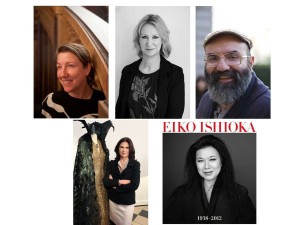
For costume designer Mark Bridges, who received an Academy Award last year for his work in Michel Hazanavicius’ The Artist, storytelling through clothes is a daring feat that is collaborative in essence. “It’s always a process and it’s not just from one person or one person’s voice,” explained Bridges. It’s the director’s voice, the actor’s voice, it’s a little bit of the original story, a little bit of practical aspects of what we can get, when and what’s available.”
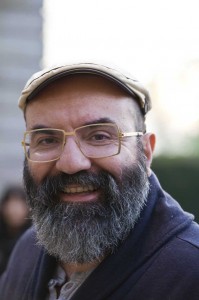
Conceptualizing the costumes took Delgado back to the original source – the 1862 book by Victor Hugo. It was a massive undertaking, not for the faint of heart, to adapt one of the most beloved stories in the world and the costume designer felt the weight of this. “The challenge was in the dimension of the film,” Delgado said. “The fact that the story covers 30 years of changing fashions from 1815-1845 and the fact that we have to put together a story that is full of grief and at the same time it is a musical that everyone knows has been one of the most successful musicals ever, having been seen by more than 60 million people.” For Delgado, enjoying the design process as a collaborative effort translated to the stunning epic that is this new adaptation of Les Misérables. The film soars as the characters are unveiled in Delgado’s designs.
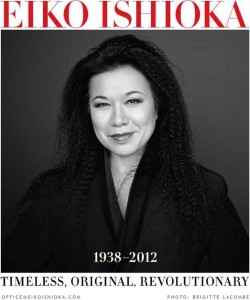 The recreation of an old fairy tale is always a fascinating sight. Eiko Ishioka’s work in Mirror Mirror directed by Tarsem Singh, is a delightful accomplishment. Ishioka is Singh’s longtime collaborator since The Cell (2000). Her long career is a diverse and colorful one, having also won a Grammy Award in 1987 for her artwork on Miles Davis’ “Tutu” album, two Tony Awards for her stage and costume design on M. Butterfly in 1988, and an Academy Award for her work on Bram Stoker’s Dracula, directed by Francis Ford Coppola in 1993. Now, exactly one decade later, the highly acclaimed Japanese designer is nominated again for her work. The honor is bittersweet. Ishioka passed away in Tokyo on Jan. 21, 2012 at the age of 73. Her work on the retelling of Snow White in Mirror Mirror is a legacy that will be remembered.
The recreation of an old fairy tale is always a fascinating sight. Eiko Ishioka’s work in Mirror Mirror directed by Tarsem Singh, is a delightful accomplishment. Ishioka is Singh’s longtime collaborator since The Cell (2000). Her long career is a diverse and colorful one, having also won a Grammy Award in 1987 for her artwork on Miles Davis’ “Tutu” album, two Tony Awards for her stage and costume design on M. Butterfly in 1988, and an Academy Award for her work on Bram Stoker’s Dracula, directed by Francis Ford Coppola in 1993. Now, exactly one decade later, the highly acclaimed Japanese designer is nominated again for her work. The honor is bittersweet. Ishioka passed away in Tokyo on Jan. 21, 2012 at the age of 73. Her work on the retelling of Snow White in Mirror Mirror is a legacy that will be remembered.
Anna Karenina is another fairy tale of sorts – albeit one gone wrong. Joe Wright’s daring production of the classic Tolstoy tale of passion blossoming into full-fledged madness had costume designer Jacqueline Durran on hand to dress the spectacle. Russian high society in the late-19th century was lived “as if on a stage,” as noted by historian Orlando Figes. Wright took his cues literally and unfolded Anna’s tragic fairy tale in a theater.
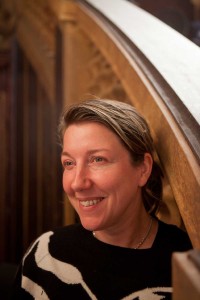 As fitting of the grandest stage production, one of the most important elements of storytelling here is costume. And like Anna, Durran embraced her role in a frenzy of both passion and madness. Durran had collaborated with Wright on his last two films, both of which earned her Academy Award nominations – Atonement (2007) and Pride and Prejudice (2005). She was involved with Anna Karenina from its inception. The first great challenge presented itself weeks into pre-production when the director decided to stage the film in a theater instead of the original settings. Durran had to acquaint herself with this new direction and re-imagine the characters she was dressing in their new setting.
As fitting of the grandest stage production, one of the most important elements of storytelling here is costume. And like Anna, Durran embraced her role in a frenzy of both passion and madness. Durran had collaborated with Wright on his last two films, both of which earned her Academy Award nominations – Atonement (2007) and Pride and Prejudice (2005). She was involved with Anna Karenina from its inception. The first great challenge presented itself weeks into pre-production when the director decided to stage the film in a theater instead of the original settings. Durran had to acquaint herself with this new direction and re-imagine the characters she was dressing in their new setting.
The highly stylized film features exquisite costumes in great volume. “The sheer number of costumes we had to make was a challenge,” Durran said. For just the stunning ball sequence, when Anna begins to court danger with the irresistible Count Vronsky, there were over 65 costumes to make for the principal characters and the crowd. The characters spin, dance and freeze in magnificent costumes as the drama tumbles toward the inevitable, ill-fated end. Of Wright’s audacious vision, Durran said, “It was all a leap of faith. The whole way of imagining was something new.” In the case of Durran’s leap, the risks gave way to a passionate collection of costumes that set the operatic stage for the classic tale.

Fairy tales abound in this year’s lineup, and the same fairy tale at that. Veteran costume designer Colleen Atwood brought her touch to Rupert Sanders’ Snow White and the Huntsman.
Atwood has a long string of accomplishments tied to her name. Her prolific work has garnered two Academy Awards – Alice in Wonderland in 2011 and Memoirs of a Geisha in 2006. She has also received six other nominations beginning with Little Women in 1995. Atwood had worked with director Rupert Sanders on several commercials and was approached by him to help recreate the ambitiously told fairy tale of Snow White and The Huntsman. “A lot of time was spent on creating the nature of the story and nature of the cast members,” said Atwood of the conceptualization process.
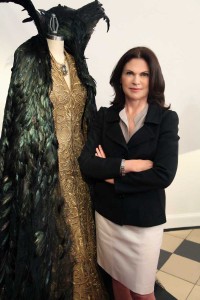 Bringing the multi-dimensional characters to life in the ominously peculiar world of Snow White meant original costume designs. Rentals couldn’t accurately portray the mood of the film. Dwarves, multiple armies, Snow White, the evil queen and the rest of the kingdom required extraordinarily specific designs. “We manufactured a huge amount,” said Atwood. “The armies’ costumes were all made by hand here in Los Angeles. We researched and designed them as prototypes nine months out, then built them – the dark army costumes at Legacy, the silver army costumes at Quantum Creation FX. Queen Ravenna, Snow White, the dwarfs, the leads were all made in my work rooms in the U.K.”
Bringing the multi-dimensional characters to life in the ominously peculiar world of Snow White meant original costume designs. Rentals couldn’t accurately portray the mood of the film. Dwarves, multiple armies, Snow White, the evil queen and the rest of the kingdom required extraordinarily specific designs. “We manufactured a huge amount,” said Atwood. “The armies’ costumes were all made by hand here in Los Angeles. We researched and designed them as prototypes nine months out, then built them – the dark army costumes at Legacy, the silver army costumes at Quantum Creation FX. Queen Ravenna, Snow White, the dwarfs, the leads were all made in my work rooms in the U.K.”
The dark and ghastly Queen Ravenna’s progression in her hunt for Snow White is thoroughly represented by her costumes at every stage in the film. When she is wed to the king, she dons a resplendent corseted wedding dress. After she murders the king, she attempts to capture Snow White’s heart in the snow. She fails and turns into crows before reappearing back at the castle in a feathered black cape. Atwood meticulously designed all of Ravenna’s costumes for each sequence and this one was a study in exquisite detail. “The feather cape was all hand cut coq feathers laid in a wonderful pattern of very light weight silk,” Atwood said. “The dress underneath was two layers of embroidery we designed and applied to some vintage gold fabric I had. It was like a magnification of wrinkled skin spun in gold.” Gold seems to be a reoccurring theme in Atwood’s work and it is an apt description altogether. After all, Snow White and the Huntsman is quite a golden achievement of the potential and power of costume design when it’s linked intricately with storytelling.
With so many elaborate and magnificently accomplished costumes this year, it’s easy to take a cue from Snow White’s tale and ask:
“Mirror, mirror on the wall, who in this [Hollywood] land is the fairest of all?”
We will just have to wait for Academy to announce the answer.
Try Below the Line’s Unofficial Awards Poll
[poll id=”19″]





